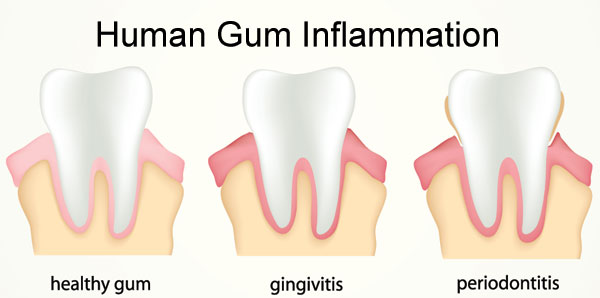There are four stages of human gum inflammation. Only three are shown in the image, because the fourth is considered to be advanced periodontitis. Gum inflammation is a disease, caused by the bacteria in plaque that can build up and infect your gums, teeth, and eventually the gum tissue and bone that support the teeth. If it affects the gum tissue and bone it can cause your teeth to become loose, fall out, or need to be removed by a dentist.
Stage 1: Healthy Gums
The first stage is normal, healthy gum tissue. Ideally, this is where you are.
Stage 2: Gingivitis
The second stage of gum inflammation is gingivitis. The earliest stage of gum disease, gingivitis is caused by a buildup of plaque at the gum line. This can be the result of toxins that irritate the gum disease when daily brushing and flossing do not remove the plaque buildup. Some bleeding may be noticeable during brushing and flossing. At this stage, damage can be reversed because the bone and connective tissue that hold your teeth in place have not yet been affected.
Stage 3: Periodontitis
The last stages of gum inflammation is periodontitis. The bone and fibers that hold your teeth in place have been irreversibly damaged. You may have started to form pockets below your gum line where food and plaque can be trapped. At the early stages of periodontitis, proper care can keep it from getting worse. In the advanced stages, the bone and fibers have been destroyed which can cause your teeth to loosen or shift. If aggressive treatment can’t save them, your teeth may need to be removed.
Gum inflammation can be prevented through daily brushing and flossing and regular dental visits. If you have gum inflammation, there are things you can do to reduce it. Between deep cleanings, periodontal cleanings, and more, your dentist will be able to put you on the path to a healthy mouth. If you think you need to see a dentist, call us at (480) 730-5000 and we can make an appointment for you today!

